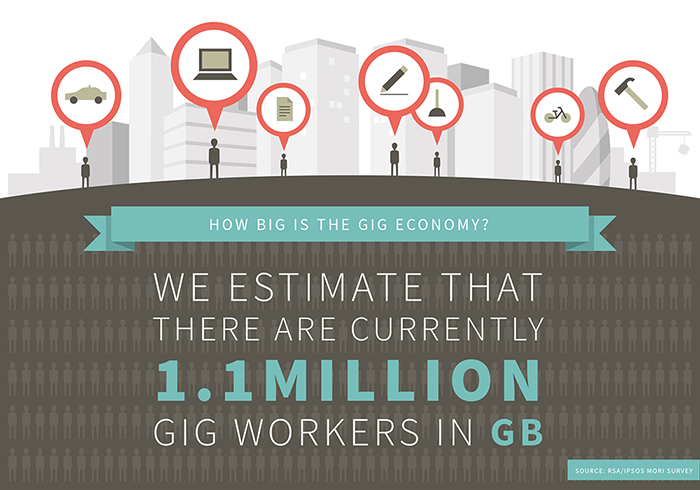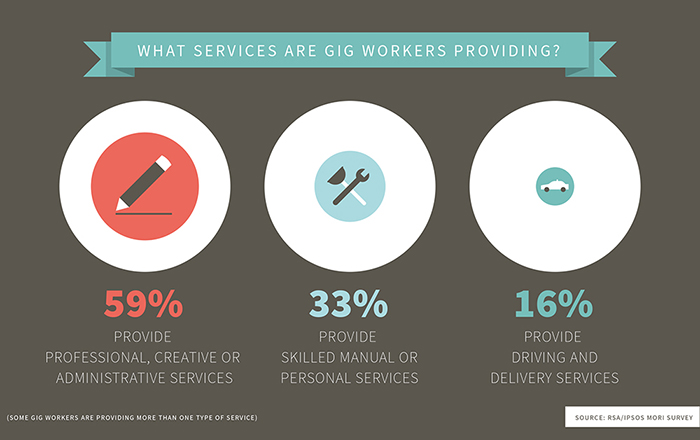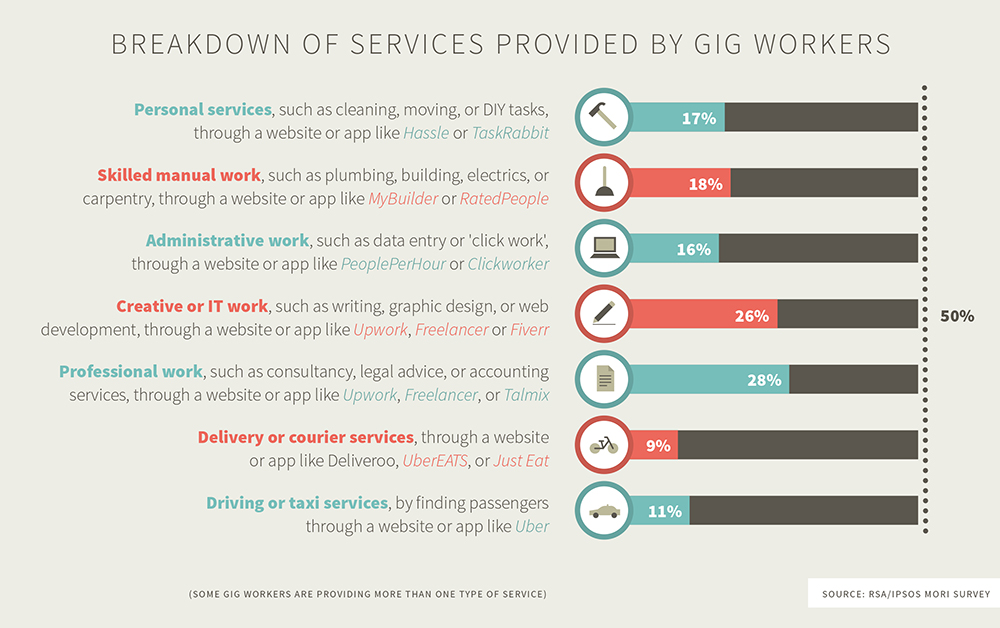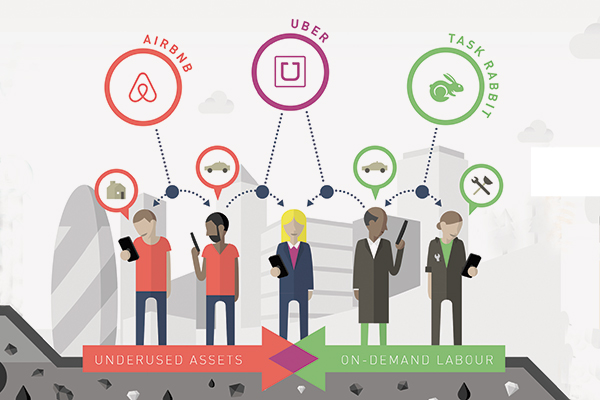It’s likely that some reading this will have recently taken an Uber to get around the city, or ordered a curry through Deliveroo on a night in. There may also be readers who are more familiar with being behind the wheel, or on a bike balancing a takeaway while skilfully manoeuvring through traffic.
Growth of Britain’s ‘gig economy’ has been profound. In a mere five years, companies like Uber and Deliveroo, which enable transportation and delivery at the tap of a button, seem to be fundamentally changing our ways of working.
These two companies in particular are in more than 75 towns and cities across the UK, while also expanding globally. Uber can be accessed in more than 500 cities around the world, while Deliveroo’s presence is strong across Europe. Both are acclaimed as ‘Unicorns’, which are start-ups valued at over a billion dollars; Uber’s worth has been pegged at as much as $62.5bn (£50bn).
When we refer to the ‘gig economy’, we are discussing the trend of using online platforms to find small jobs, sometimes completed immediately after request (essentially, on-demand). Much like an actor or musician goes from ‘gig to gig’, workers in the gig economy are sourcing one job at a time, but by logging into an app or clicking through to a website. Each ride an Uber driver accepts is a ‘gig’ or a single job, as is each booking a Hassle cleaner makes to tidy a flat or every errand run through TaskRabbit.
While online platforms for sourcing gigs (in the form of ‘crowdwork’) have existed for more than a decade, the trend has accelerated in the UK since 2012 as an aspect of the ‘sharing economy’. In the sharing economy, there are two kinds of platforms — asset-based platforms, and labour-based platforms.
- Asset-based platforms entail sharing an underused asset, such as a home, as hosts do on Airbnb.
- Labour-based platforms are premised on making the most of one’s skills or time, such as through driving for a few hours a week in addition to other commitments, such as another job, caring responsibilities, or creative pursuits.
Labour-based online platforms
We include all online platforms for sourcing gigs in our survey and analysis, but are particularly interested in the recent drivers of growth in the gig economy — the labour-based platforms of the sharing economy
These platforms tend to consider gig workers to be self-employed, or ‘independent contractors’, citing the flexibility they have over choosing their own hours. The gig economy is thus sometimes conflated with the general trend towards self-employment or ‘independent work’. Estimates of these workers in the UK have thus ranged from six million to 14 million; however, even the more cautious estimates appear inflated because of the definitions or methodology used.
Considering that gig work has become increasingly controversial because the workers are classed as self-employed, rather than as employees of the platform, it’s important to clearly distinguish between gig workers and traditional freelancers.
Platforms are perceived to be driving a shift from traditional employment to self-employment, and thus threatening what has long been the foundation of social and economic security for most workers.
Some argue that platforms are misclassifying workers as self-employed, depriving them of rights and protections while still exercising control akin to employers. There are also concerns about how this affects public finances because the self-employed and the companies that contract them pay a lower rate of tax than employees and the businesses they work for.
Largest survey on British gig economy
As a starting point for thinking through any legal or political reform that might be needed, the RSA set out to learn more about the nature of Britain’s gig economy. In collaboration with Ipsos MORI, we undertook the largest survey on the gig economy in Britain.

Nearly 8,000 people in the population over the age of 15 were surveyed face-to-face, meaning that they were interviewed in their homes, rather than online. This methodology gives us the truest indication of the gig economy’s size in terms of the workforce.
According to our survey, we can estimate that there are currently 1.1 million gig workers in Great Britain. Around 3 percent of adults aged 15+ have tried gig work of some form, which equates to as many as 1.6 million adults in Great Britain.
For some, this may be a smaller proportion of Britain’s workforce than imagined, especially given higher estimates that have encompassed the general trend of independent work or freelancing, and users of asset-based platforms like HomeAway or LoveHomeSwap.
That said, over a million workers in a relatively new market that is continuing to grow is significant. This amounts to almost as many workers as are in the National Health Service (NHS) England (1.2 million).
What services are being provided?
We grouped gig work into three main categories:
- Professional, creative or administrative services
- Skilled manual or personal services
- Driving and delivery services
Well over half (59 percent) are found in professional, creative, or administrative services. This was to be expected given that before the rise of the ‘sharing economy’, platforms had been established mainly for freelancers, such as copy editors or graphic designers,interested in finding consultancy opportunities. Over time, platforms have also provided opportunities to perform simpler tasks like clickwork or data entry. These types of jobs are sometimes referred to as ‘crowdwork’ because they’ve been crowdsourced online.

Similarly, it was anticipated that there would be a significant number of gig workers providing skilled manual services, such as plumbing, electrical maintenance, or carpentry. Workers in the skilled trades who are self-employed have long been sourcing jobs online through platforms such as MyBuilder and Rated People, both of which were founded circa 2005.
It may surprise some that gig workers providing driving and delivery services were found to be in the minority. This may be because of the high visibility of these workers on our roads in contrast with freelancers working from home, or for example, plumbers or electricians disappearing into other people’s homes to carry out their tasks. Yet, given that driving and delivery platforms were the most recent to be established in the UK, this too should tally with our expectations. This is still a substantial share of gig work given these platforms only emerged within the last five years.
A further breakdown of these main categories can be found below. Note that this shows us that some gig workers are providing more than one type of service.
Related articles
-
What is the gig economy?
Brhmie Balaram
The growth of Britain’s ‘gig economy’ has been profound. But what exactly do we mean by the gig economy?
-
Making the gig economy work for everyone
Brhmie Balaram
There are now an estimated 1.1 million people in Britain’s gig economy, which is nearly as many workers as in the National Health Service (NHS) England. Brhmie Balaram introduces our latest report into the gig economy.
-
Blog: Top 5 takeaways for Government on the Sharing Economy
Brhmie Balaram
The RSA was asked to present evidence to the BIS Select Committee last week as part of the government’s inquiry into the digital economy. Brhmie Balaram gives her top five takeaways.





Be the first to write a comment
Comments
Please login to post a comment or reply
Don't have an account? Click here to register.